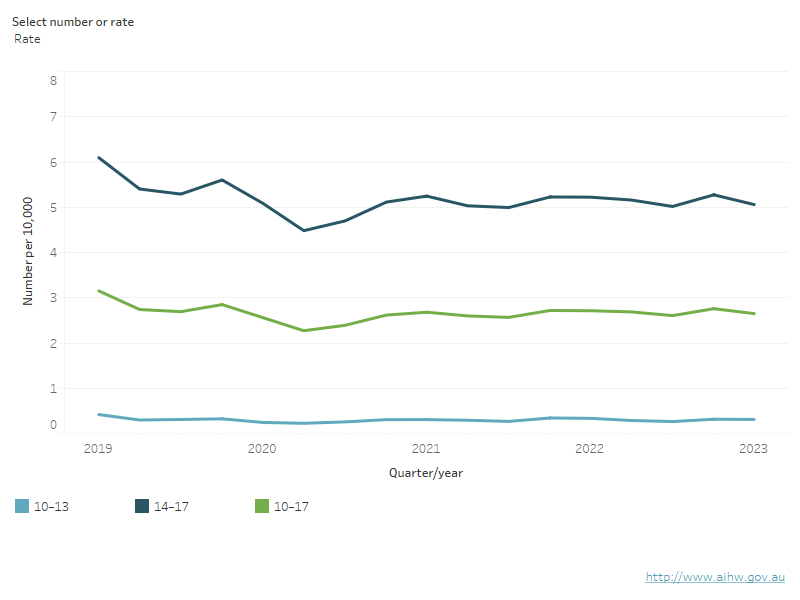Trends in detention
On this page:
Key findings
- On an average night in the June quarter 2023:
- there were 812 young people in youth detention in Australia
- the rate of young people aged 10–17 in detention was 2.6 per 10,000
- most (648 or 80%) young people in detention were aged 14–17
- 9 in 10 (726 or 89%) young people in detention on an average night were male.
- On an average night over the 4-year period from June quarter 2019 to June quarter 2023:
- the number of those young people aged 10 and over fell from 941 to 812
- the rate of those aged 10–17 fell from 3.2 to 2.6 per 10,000.
How many young people were in youth detention?
On an average night in the June quarter 2023, there were 812 young people in youth detention in Australia due to their involvement, or alleged involvement, in crime.
On an average night in the June quarter 2023:
- most (689 or 85%) young people in detention were aged 10–17. Of these, 41 were aged 10–13 and 648 were aged 14–17
- the remainder (123 or 15%) were aged 18 or over (Figure 1.1).
The average nightly population is rounded to whole numbers, so components might not sum to the totals due to rounding (see Technical notes).
On an average night in the June quarter 2023:
- the rate of young people aged 10–17 in detention was 2.6 per 10,000, while the rate for young people aged 10–13 was 0.3, and 5.1 for those aged 14–17 (Figure 1.1)
- nearly 9 in 10 (726 or 89%) young people in detention on an average night were male.
Figure 1.1: Young people in detention on an average night, by age group, June quarter 2019 to June quarter 2023 (number and rate)
The rate and number of young people in detention on an average night was highest for those aged 14–17. Rates and numbers have remained steady across age groups since 2021.

Notes
- Trend data may differ from those previously published due to data revisions.
- For data extracted from the YJ NMDS, age is calculated at the start of the relevant quarter unless the period of detention began within the quarter or the young person had a birthday, in which case age is calculated as at the start of that period or from their birthday.
- Rates are the number of young people per 10,000 relevant population.
Source: Supplementary tables S11, S12, S13, S14, S15, S16, S17 and S18.
How did the number of young people in youth detention change over time?
The number and rate of young people in detention fell from 941 in the June quarter 2019 to 812 in the June quarter 2023; the rate fell from 3.2 to 2.6 per 10,000.
Both the number and rate of young people in detention were lowest in the September quarter 2020, with the number at 723 and the rate at 2.3 per 10,000.
The rate of young people aged 14–17 in detention followed a similar trend to those aged 10–17, although the rates were slightly higher (Figure 1.1).
For those aged 10–13, the rate of young people in detention on an average night in the June quarter 2023 was 0.3 per 10,000. This was slightly lower than in the June quarter 2019 when the rate was 0.4 per 10,000 (Figure 1.1).
The number of young people in detention on an average night declined in all age groups from the June quarter 2019 to 2023:
- The number of those aged 10–13 in detention declined slightly over the 4-year period, from 52 to 41.
- The number of young people aged 14–17 in detention declined from 706 to 648 and was lowest in the September quarter 2020 (538). This age group drove an overall decline in the number of young people aged 10–17 in detention, from 758 to 689 over the 4-year period.
- Those aged 18 or over showed a steady decline from 182 to 123 young people over the 4-year period (Figure 1.1).
Young males were far more likely to be in detention on an average night than females. This was the case in all quarters throughout the 4-year period for males aged 10 and over (89%–92%). However, for young people aged 10–13 there was a slightly lower proportion of males in detention on an average night (75%–89%).


